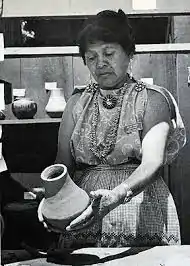Crucita Gonzales Calabaza[1] | |
|---|---|
| (Blue Corn) | |
 Crucita Calabaza (Blue Corn) | |
| Born | Crucita Gonzales[1] December 7, 1921 |
| Died | May 3, 1999 (aged 77) |
| Nationality | San Ildefonso Pueblo, American |
| Occupation(s) | Native American Potter and Artist |
| Known for | Polychrome San Ildefonso Pueblo Pottery |
| Spouse | Santiago "Sandy" Calabazas |
| Children | 10 |
| Relatives | 18 grandchildren, 12 great-grandchildren |
Crucita Gonzales Calabaza[1] (December 27, 1921 – May 3, 1999), also known as Blue Corn, was a Native American artist and potter from San Ildefonso Pueblo, New Mexico, in the United States. She became famous for reviving San Ildefonso polychrome wares and had a very long and productive career.[2][3][4]
Early life
Crucita Gonzales was born on December 27, 1921, in San Ildefonso Pueblo[3] in Santa Fe County, New Mexico. Her maiden name is also spelled Gonzalez. Her grandmother first introduced her to pottery-making at the age of three. Maria Martinez's sister gave her the name Blue Corn during the people naming ceremony. Calabaza learned the black-on-black pottery tradition from Martinez.[5]
Blue Corn attended school at the pueblo in her early years. She then went to Santa Fe Indian School, which was 24 miles (39 km) from home. While attending school in Santa Fe, her mother and father died, and she was sent to live with relatives in southern California where she worked as a maid for a short time in Beverly Hills.[6]
At the age of 20, she married Santiago "Sandy" Calabaza, a silversmith from Kewa Pueblo. Together they settled at San Ildefonso, where she bore and raised 10 children. During World War II, Blue Corn worked as a housecleaner in Los Alamos for the physicist, J. Robert Oppenheimer.[7]
Career
After her first son, Joseph, was born, she returned to pottery making. Santiago quit his job to help her carve, paint, and design her pots. By the late 1960s she had established herself as a leader in polychrome styles. After her husband died in 1972, her son Joseph began helping her with her pots. During the 1960s and 1970s, she led many workshops on pottery making in both the U.S. and Canada. Although Blue Corn also made redware and blackware, she is especially noted for her finely polished slips and exhaustive experimentations with clays and colors, producing cream polychrome on jars and plates. She is particularly well known for her feather and cloud designs.[8][4]
Blue Corn is known for the reintroduction of polychrome fine whiteware and has received critical acclaim from several publications including The Wall Street Journal. Her pottery can be found in the Smithsonian Institution and other leading museums throughout America and Europe as well as in private collections. She won more than 60 awards including the 8th Annual New Mexico Governors Award in 1981. This is New Mexico's greatest recognition of artistic achievement.[9]
Death
Calabaza died on May 3, 1999, leaving ten children, 18 grandchildren and 12 great-grandchildren.[10][11]
References
- 1 2 3 "Museum Management Program: Plate". National Park Service. US Department of the Interior. Retrieved 2 December 2023.
- ↑ American Indian Textiles: 2,000 Artist Biographies, C. 1800-present ... Gregory Schaaf, Angie Yan Schaaf - 2001 - Blue Corn (Crucita Gonzales, Crucita Calabaza) (San Ildefonso, Tewa, active ca. 1940s-90s: weaving, pottery) LIFESPAN: December 7, 1921 - May 3, 1999 FAMILY: adopted daughter of Ramona Sanchez Gonzales & luan Gonzales; wife of ...
- 1 2 "Crucita Calabaza - Blue Corn". Adobe Gallery, Santa Fe. Retrieved 2019-02-28.
- 1 2 https://sirismm.si.edu/EADpdfs/NMAI.AC.072.pdf Smithsonian National Museum of the American Indian
- ↑ Peterson, Susan (1997). Pottery by American Indian Women: The Legacy of Generations. Washington DC: National Museum of Women in the Arts and Abbeville Press. pp. 100–107. ISBN 0-7892-0353-7.
- ↑ "Gonzales Calabaza". The Marks Project. 2018-05-13. Retrieved 2019-02-28.
- ↑ Rubenstein, Meridel; Zweig, Ellen (1995). "Critical Mass". Conjunctions (24): 164–187. JSTOR 24515517.
- ↑ "Blue Corn (Crucita Gonzales Calabaza) (1921-1999) - San Ildefonso Miniature Black Pot, 1\". MedicineMan Gallery. Retrieved 2019-02-28.
- ↑ "Blue Corn, San Ildefonso Pueblo Potter, Penfield Gallery of Indian Arts". Penfield Gallery of Indian Arts. Retrieved 2019-02-28.
- ↑ "San Ildefonso Pueblo". Crucita Blue Corn Calabaza Pottery. 1999-05-03. Retrieved 2019-02-28.
- ↑ "Crucita Calabaza - Historical records and family trees". MyHeritage. 2019-02-27. Retrieved 2019-02-28.
- Allan Hayes and John Blom, 1996, Southwestern Pottery: Anasazi to Zuni
- Peterson, Susan, 1997, Pottery by American Indian Women: The Legacy of Generations
- Schaaf, Gregory, 2000, Pueblo Indian Pottery: 750 Artist Biographies